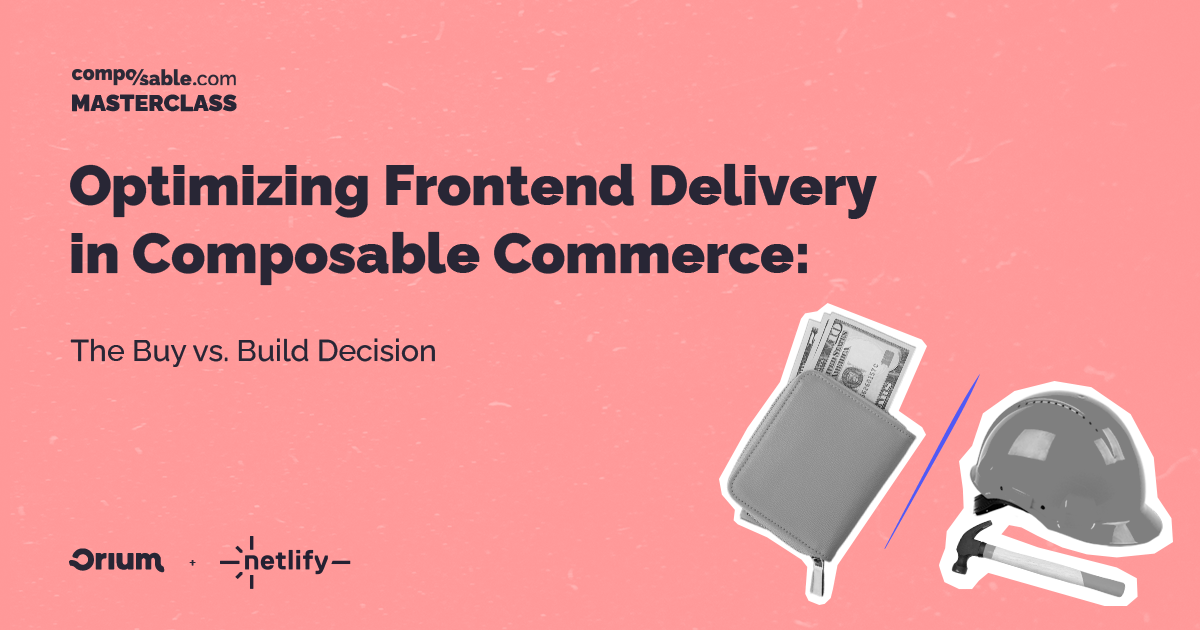Realizing your rigid infrastructure has drawbacks is the first step toward modernizing your monolithic architecture. Nonetheless, migrating from a monolith to a composable architecture is a massive undertaking, especially in large, complex organizations. That’s why we partnered with several digital transformation agencies to ease the transition away from your legacy web architecture.
In this post, we’ll uncover if a build vs. buy approach is right for you, the challenges of migrating yourself, and which all-new partner migration offer matches your business needs.
Is a build or buy approach right for me?
The benefits of composable architecture are clear. If you’re grappling with challenges that include flexibility, optionality, time-to-market, and scalability—to name a few—it might be time to consider if building a composable architecture is right for you.
A composable architecture allows organizations to build rich, omnichannel digital experiences on their terms, free from any limitations imposed by monolithic architecture. But a wider range of possibilities spells potential challenges for your business:
- Where to start: While a monolithic architecture offers simplicity—driven by one vendor and ultimately a single point of failure, the appeal is there. However, a composable architecture brings together the focus of best-in-class vendors to help you piece together a solution tailor-made for your organization.
- What to build: The primary benefit of a composable architecture is its flexibility. If you need a specific solution to solve a particular problem, composable architecture allows you to select the pieces that make the most sense. However, with more choices comes more crucial decisions to make.
- How to bring teams together: The flexibility of a composable architecture is only valuable if you can bring your in-house teams together to agree on the best way to use it. Organizations must collaborate by clearly defining cross-team goals and make sure departments work together to achieve them.
While the benefits of a composable architecture are clear, they often spell the same pitfalls that organizations encounter when migrating themselves.
To learn more, check out this composable.com Build vs. Buy Masterclass, presented by Netlify and Orium.
The challenges of migrating to composable architecture, alone
According to Gartner, by 2026 all the top 20 cloud platform and SaaS providers will offer component marketplaces to enable customers’ composable strategies. But, while enterprise organizations recognize the benefits of composable architecture, many find the transition from legacy architecture to composable risky, time-consuming, and resource-draining.
Further, businesses need to maintain their websites and applications running before, during, and after migration to ensure seamless customer experiences.
With the right partnership, users can go to market and build web front-ends much faster, while connecting tools across workflows to reduce bottlenecks. The result is high-performing digital experiences built quickly, flexibly, and painlessly.
Which begs the question: Who should I partner with for my migration?
Introducing all-new partner offerings for composable migration
It’d be unrealistic to think that every partner program is the best for your business and use case. Understanding that business challenges are unique, we’ve partnered with several leading agencies to build accelerator programs that match your needs.
Let’s take a look at each program.
VShift: Recommended for migrating from Adobe Experience Manager (AEM)
Adobe is the most widely used digital experience platform (DXP) among large, regulated industry organizations. Not to mention, many marketers and non-IT digital transformation sponsors struggle with its flexibility, speed-to-market, and cost.
“According to MACH Alliance’s research, 9 out of 10 decision-makers say composable technology will be instrumental to their organization’s success in the next five years.” Eric Feige, Manager Director of Strategy at VShift.
This is why Netlify partner, VShift, created the AEM integration, included in their new AEM Digital Experience Accelerator program. Now, business-level decision-makers, developers, and marketers throughout the migration process will be able to:
- Connect to composable tools to improve workflows
- Enable a seamless integration of omnichannel touchpoints
- Ensure improved personalization capacity in components and branding
- Deliver improved speed to market by quickly and efficiently publishing pages and content
For more information, check out the AEM integration or AEM Digital Experience Accelerator.
GEAR Accelerator by Valtech: Recommended for migration in the manufacturing industry
The GEAR Accelerator by Valtech is tailored for the manufacturing industry focusing on aftermarket commerce via customer portals, enhancing B2B functionalities with Netlify’s secure, adaptable architecture for rapid innovation, aftermarket commerce use cases, and related integrated services via customer portals.
CAFE (Composable Accelerator for Enterprises) by Apply Digital: Recommended for solution-led projects
The CAFE Accelerator by Apply Digital helps enterprises accelerate project timelines with a flexible suite of tools and integrations. Ideal for rapid proofs of concept and solution-led projects, CAFE’s collaborative approach ensures internal buy-in and minimizes decision-making fatigue, providing a quick path from sandbox to live deployment, helping clients achieve ROI, meet MVP deadlines, and reduce integration risks.
XCentium’s Composable Accelerator: Recommended for the financial services industry
XCentium’s Composable Accelerator offers customizable, performance-focused solutions for the financial services industry, enabling rapid deployment and significant cost savings with pre-built templates, multi-language support, and seamless technology integration.
The bottom line on agency partnerships for composable migration
While companies recognize the importance of digital modernization, the reality is that budgets have tightened while expectations continue to grow. Netlify and its partner ecosystem offer several accelerators to ease the transition from monolithic to composable architecture by offering immediate reductions in development costs and faster time-to-market, all built on leading-edge composable standards.
Looking to get started? For more information and a free consultation, reach out to one of our experts.








